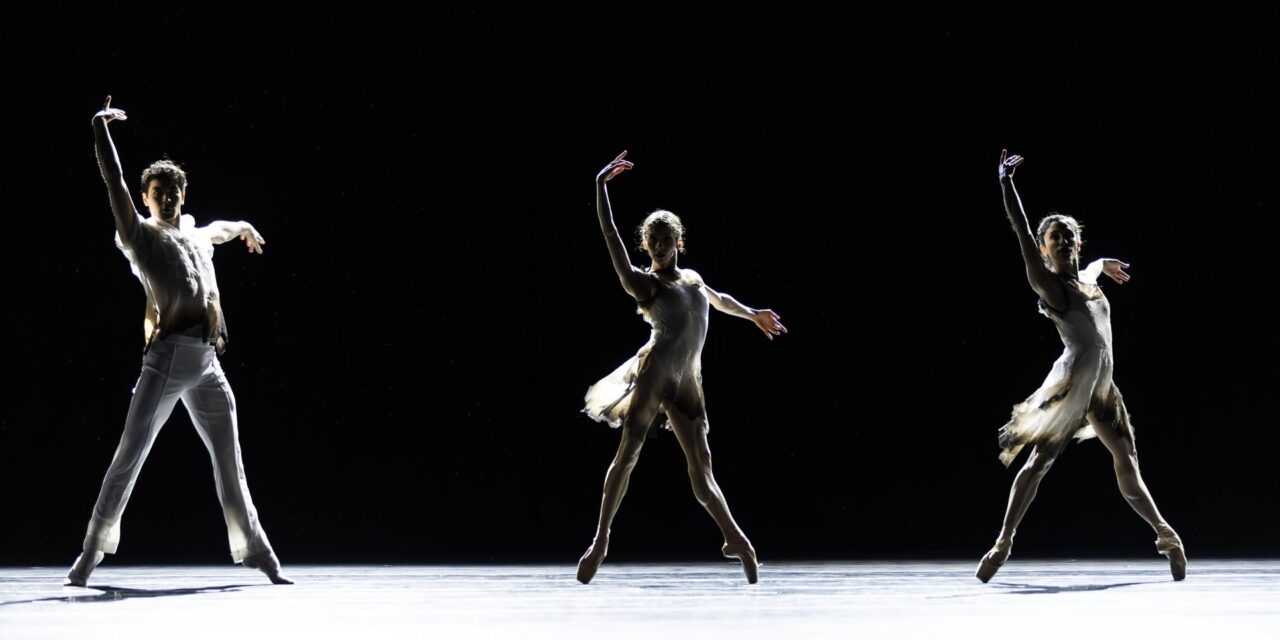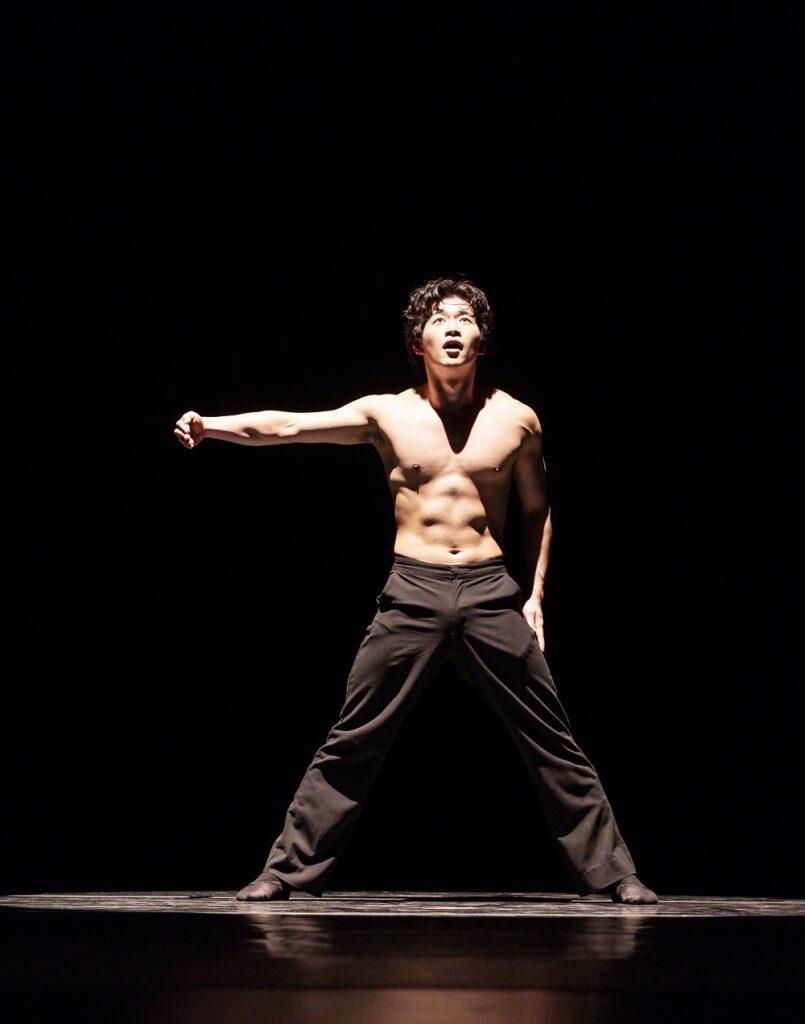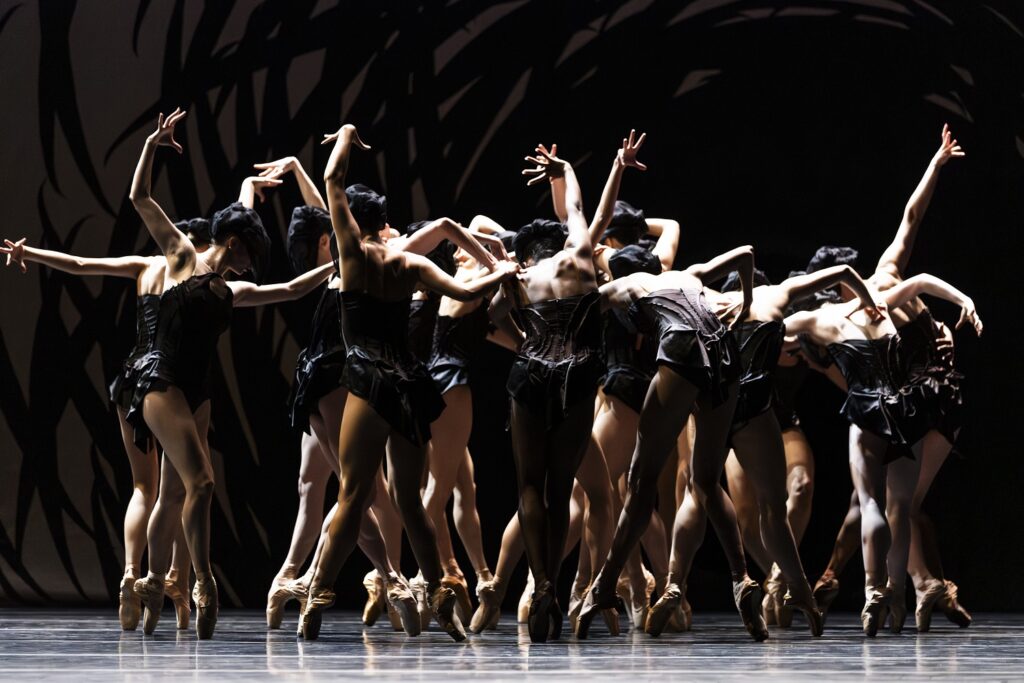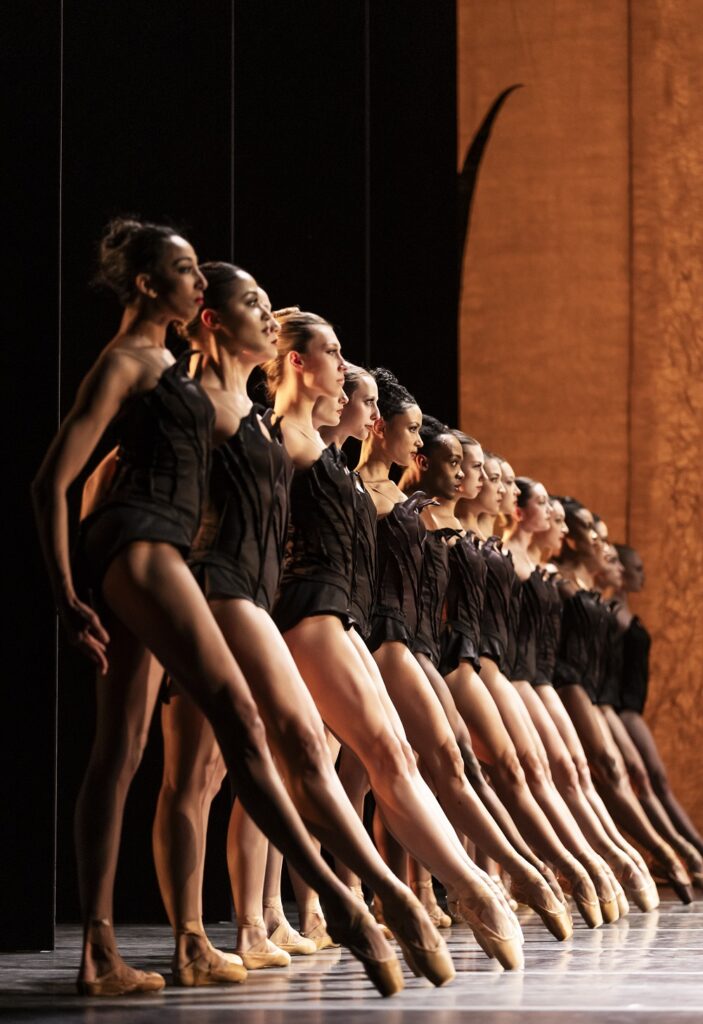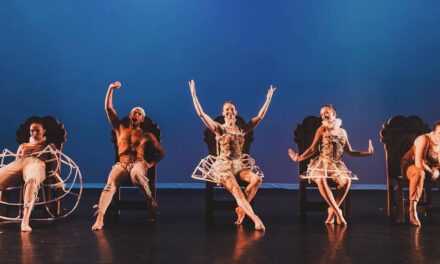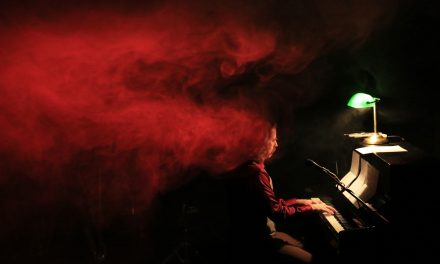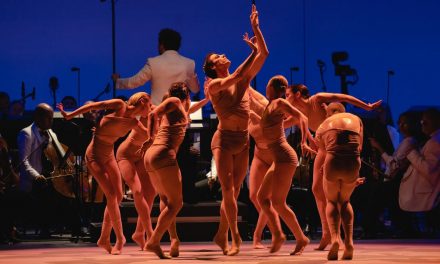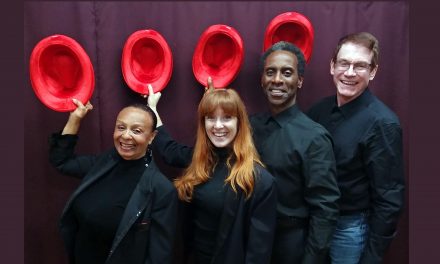The first in a series of pieces about the theme of “emerging” is by a choreographer, just 33 years of age, Price Suddarth a dancer and choreographer for Pacific Northwest Ballet (PNB). His endeavor is called Dawn Patrol. It is clear his talent lies in his staging of theme and variations, canons, pas de trois, deux, and solo tour de force. The talented and beautiful PNB dancers, Leta Biasucci, Elle Macy, Clara Ruf Maldonado, Sarah-Gabrielle Ryan, Christopher D’Ariano, Kyle Davis, Luther DeMyer, Noah Martzall, Christian Poppe, and Dylan Wald clearly express their dedication and effort to give 110 percent to Suddarth’s ballet, showing the choreographer in his best light.
This piece expresses Suddarth’s eye for contemporary ballet with its off-kilter promenades, effortless circular glided partnering, its facile lifts from floor to shoulder, and the powerful simplicity of unison lines to the effective romance of music by Alfonso Peduto’s war reminiscences; all pegging Suddarth’s musicality. As a designer of dance there is no doubt he is an emerging talent, bubbling over with ideas, his sense of lyricism and power is there and exposed in all its youthful glory.
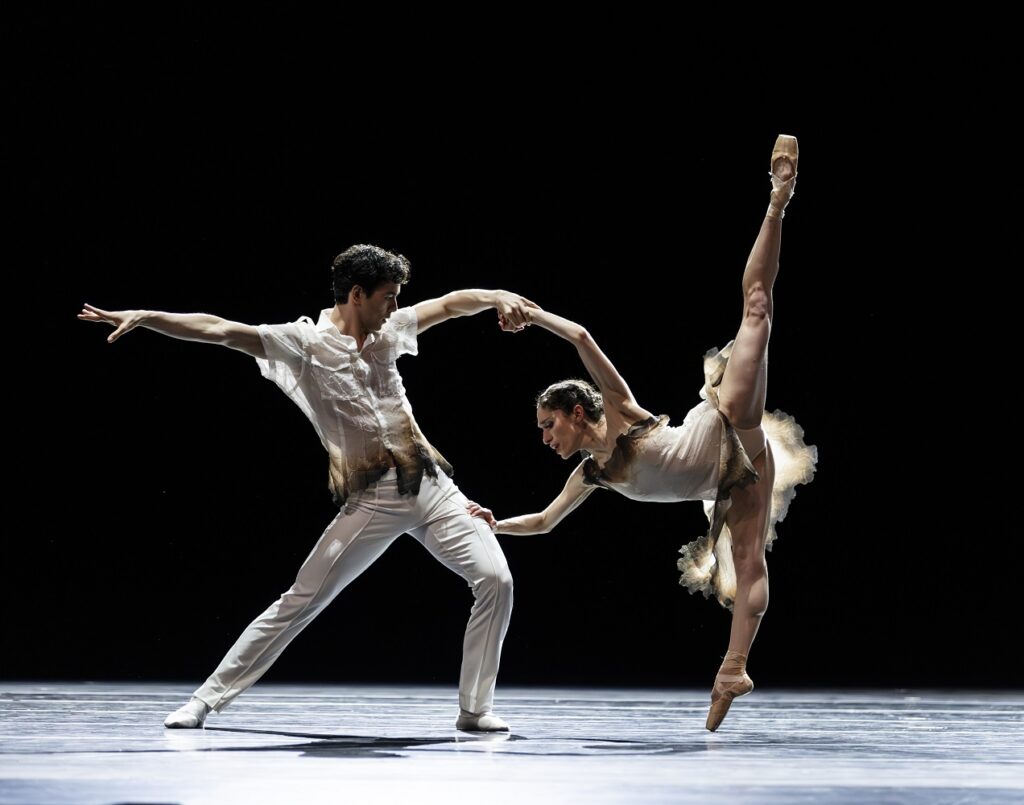
Pacific Northwest Ballet soloist Christopher D’Ariano and principal dancer Leta Biasucci in Price Suddarth’s “Dawn Patrol” – Photo © Angela Sterling.
In the “Program Notes” by Emma Love Suddarth, she mentions that this is an exploration of the Dawn Patrol pilots during WWII. She speaks about courage, personal sacrifice, contrast and inner turmoil of the young aviators…”soaring above the clouds at sunrise, yet beneath them lies the ominous shadow of enemy territory.” This intro exposing the fact that this piece had to do with “Pilots and WWII” was in the notes, but not on the stage. The dancing was beautiful, but the story unclear in this difficult and overlong piece. The Ballet shows emotion and interesting configurations, but nowhere do we see the stated narrative or does it give a hint with its blackened stage and overhead set designed by Chrisoula Kapalonis. The only hint is the lovely costuming by Mark Zappone of flowing shirts and skirts with burnt hemlines.
This Premiere piece, may do well to partner with a dramaturg for the desired effect, to move the audience, not only with beautiful choreography, but with fulfillment of the stated concept. One might then find the full greatness in this ballet.
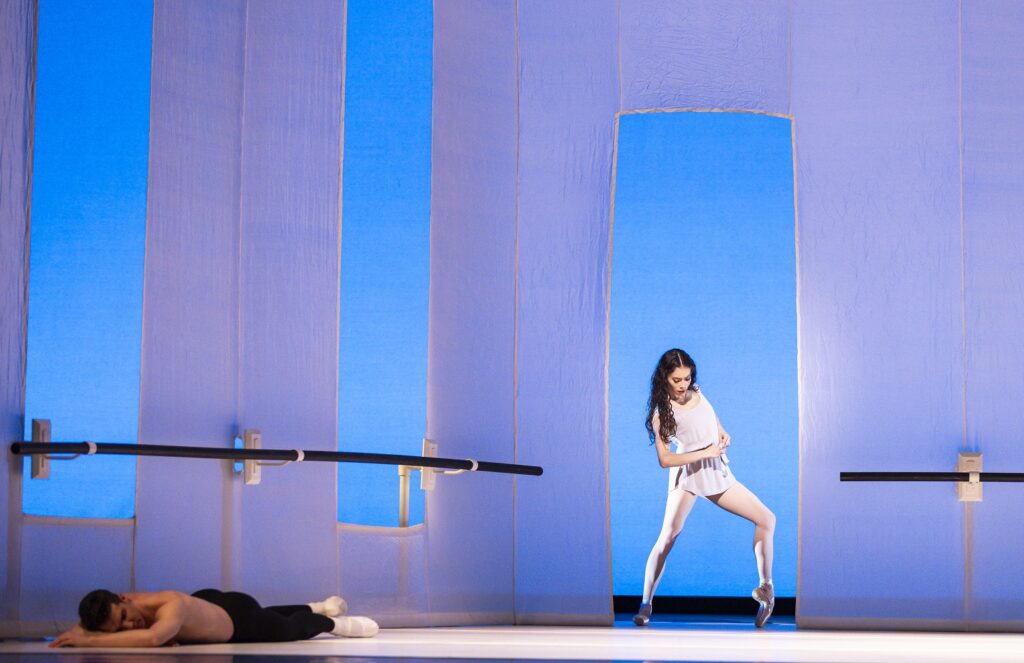
Pacific Northwest Ballet principal dancer Lucien Postlewaite and soloist Clara Ruf Maldonado in Jerome Robbins’ “Afternoon of a Faun” – Photo © Angela Sterling.
Next was Jerome Robbin’s Afternoon of a Faun with music by Claude Debussy. Robbins dedicated this piece to the beloved Tanaquil LeClercq, Balanchine’s wife, struck down all too soon with polio. The piece takes place in a simple stylized dance studio and, as the story goes, Robbins, as he passed by the dance studio, was inspired by a sleeping Edward Villela on the empty dance floor, bathed in sunlight. He then began reworking the original ballet of Afternoon of a Faun, by the Ballet Russes’ great Vaslav Nijinsky. Robbins, fascinated by the elusive LeClerq, cast her and her original partner Francisco Moncion, and later Jacques D’Amboise, to perform the ballet. It soon become one of his brilliant classic pieces.
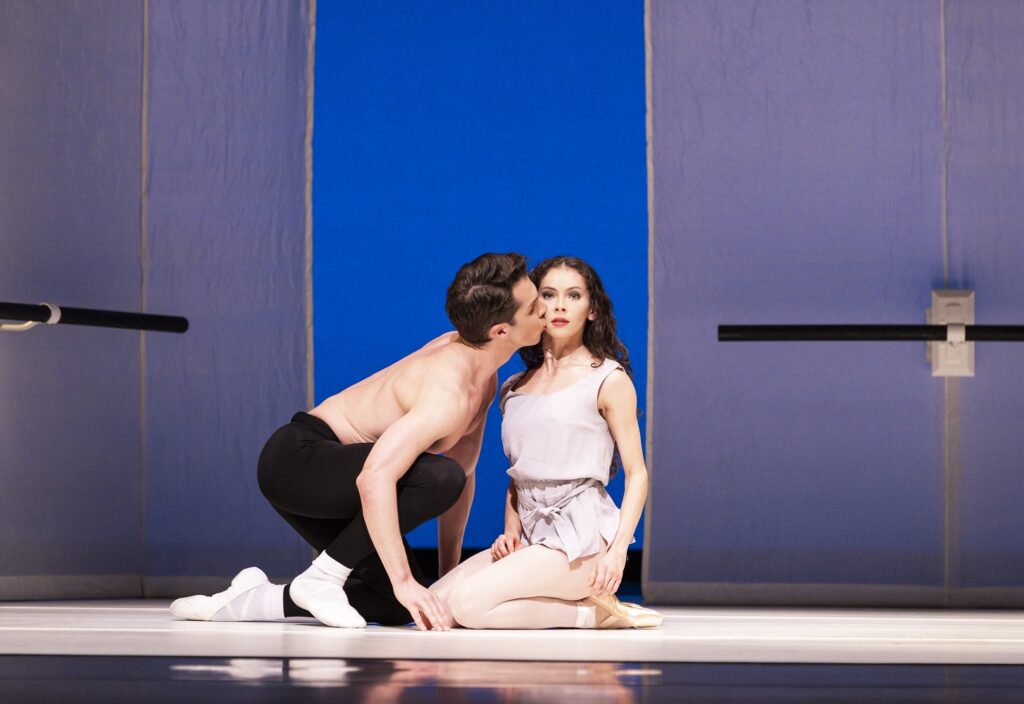
Pacific Northwest Ballet principal dancer Lucien Postlewaite and soloist Clara Ruf Maldonado in Jerome Robbins’ “Afternoon of a Faun” – Photo © Angela Sterling.
In PNB’s performance, the captivating Lucien Postlewaite plays the Faun. As his character, he is mesmerized by his own image in an imaginary mirror in front of him. While looking at himself, a Nymph appears, the exquisite Clara Ruf Maldonado. Her long legs and doe-like presence is an excellent counter to Postlewaite. Beguiled and unhurried, their encounter with each other unfolds into a powerful focus, ending in their acquiescence for just a moment. Then soon the Nymph disappears thru the door, as though just an apparition, and fades away, leaving the Faun quiet in thought to again contemplate his image.
The lovely subtle re-staging by Bart Cook allows Postlewaite’s generosity and sensitivity to emerge. On their knees, the Faun’s tentative reach for her adds such presence and power to their fascination. Adding to the focus on the performers was the lucid set and lighting by Jean Rosenthal, with simple costuming by Irene Sharaff, both were the original designers of this ballet. Even though this lovely meditation was done in 1953, it appears uniquely contemporary and effective even today.
The next work called MOPEY is a work that appears to be the unfiltered idea of a petulant child, with little focus and much to do about being silly, cute, and just for show. The choreography by Marco Goecke, restaged in 2005 by Sean Suozzi and again in 2025 by James Yoichi Moore, seemed to be created out of a rough weekend with an unruly 4 year old. Much of it introduced activities, with impossible energy and in need of a breather, not only for the wonderful, strong, Kuu Sakuragi but also for the audience.
With the series of gags and sleight of hand, appearings and disappearings, and silences for no reason, with intermittent throwing of fits… It appeared geared for affect with nary a reason to be doing it at all, other than showing us a rampage, which we have plenty of these days. The first piece, conducted by Josh Archibald-Seiffer was bright and engaging, even though written several hundred years apart. The first was C.P.E. Bach’s Cello Concerto in A minor, Wq. 172, and next came a recording of The Cramps’, “Surfin’ Bird” which added to the frenetic head banging rhythms…fashioned after the 1950’s Silhouettes “Get a Job.”
The lighting design by David Moodey was…well, Moody, mostly dark with spots picking up and doing away with Sakuragi’s image. All in all, this was a puff piece emerging out of nowhere…and never really going anywhere.
And lastly, but most definitely worth the wait, is the genius of Crystal Pite’s choreographic soul of designing dance. She seems to find the base and depth in the drama of discovery. Emergence is a remarkably raw example of just this kind of primal mergings. Pite’s Emergence premiered in 2009 by the National Ballet of Canada, re-staged by Hope Muir, then again by Anne Dabrowski for PNB in 2023.
Costume designs by Linda Chow are simple, symbolic and primal, with male dancers in hieroglyphic patterned black pants and bare chested tattooed scrollwork spreading over shoulders and arms. The fascinating, seemingly pencil-point, pointe work of the female dancers challenged against the low modern movement of the males showed the dichotomy.
The stunning first variation embodied a kind of chrysalis, like a nascent bat-like creature emerging, fighting for its survival and balance. Dancer Leta Biasucci’s interpretation was amazing not only for her trust, but for her total abandon. Her partner, Miles Pertl so beautifully focused, so protective and caring, was miraculous to watch. Elle Macy and Dylan Wald were so solid and mature in their confident exploration.
The powerful corps of male Bee “creatures” were impressively strong, backed by Jay Gower Taylor’s fascinating backdrop with its black strips of cyclone swirls on a hot orange background. The creatures pulsated in rhythm, stopped, as their shining backs and chests heaved audible breaths soon brought them together, followed by the sounds of boots on the ground. And like herds, they began to march then run when the females on pointe, in hooded beaks, glided in. Shifting, soon changing places, their pointed feet somehow made a hawk-like statement. They appeared to then be pushed by some ethereal wind. Their sudden arm movements embellished the action and moved into anarchic constructions. When they finally alighted from the structure, they again, moved fitfully into another wild form.
Alan Brodie’s unworldly lighting accentuated Owen Belton’s fascinating sound scapes and powerful pulsating rhythms. The breathing of the artists in battle with the elements by the composer evokes an emotional remembrance that creates a kind of chaotic perfection, a quality and tolerance for this primordial chaos and order. A sudden taste of hip hop on pointe picks up the uniqueness of the ballet and street dance, with the breadth of counter rhythms.
So Pite’s concerns can be put to bed. This unworldly piece does “expose something beautifully human, something that [truly] vibrates with life.” And to quote the artist herself, this piece “echoes the intelligence and beauty of emergence in the natural world.” It plays back in one’s soul, a message of nature and humanity. A transcendent work is what can truly be said about Pite’s masterpiece.
To learn more about Pacific Northwest Ballet, please visit their website.
Written by Joanne DiVito for LA Dance Chronicle.
Featured image: L-R Pacific Northwest Ballet soloists Christopher D’Ariano and Clara Ruf Maldonado with principal dancer Leta Biasucci in Price Suddarth’s Dawn Patrol – Photo © Angela Sterling.

